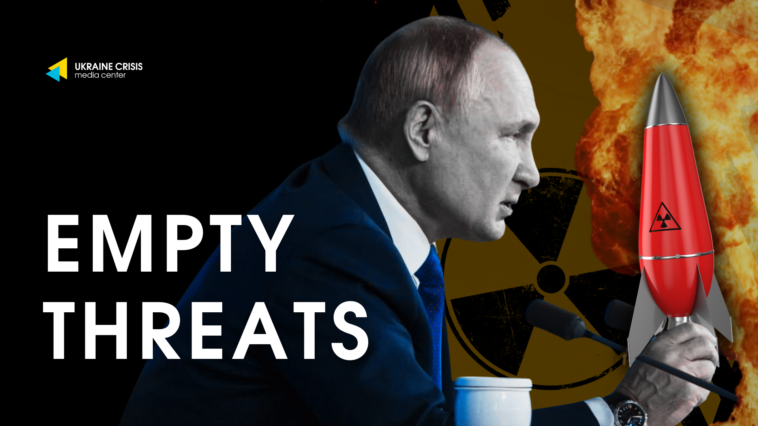Matt Wickham UCMC Analyst
Putin has called for amendments to Russia’s nuclear doctrine, reigniting fears in the West of an all-out nuclear war. But what do these theatrics really mean? Do they really bring the world closer to the brink of nuclear war, or are they just another round of empty threats aimed at meddling in the US elections? Perhaps they serve solely to deny Ukraine the green light to strike into Russia or an attempt to appease Russian propagandists who are “sick” of their country appearing weak under Putin’s ever-moving red line rhetoric.
Rattling the Kremlin
Nuclear threats, the Kremlin’s favourite fearmongering tool, have failed to inspire the level of terror intended since the start of this war. These threats have resurfaced periodically throughout the invasion, with two clear objectives: to deter the West from providing Ukraine with military aid to Ukraine and to project strength domestically, reinforcing the message that no one should dare challenge “almighty” Russia.
Ukraine’s seemingly never-ending wait for the official green light to strike deep into Russia remains in limbo. However, weeks of back-and-forth meetings between top Western leaders, Zelensky’s trip to Washington, and the upcoming meetings involving the UK, U.S., France, and Germany have clearly rattled the Kremlin. Putin’s nuclear rhetoric, after all, only seems to surface when Russia is losing leverage.
Cosmetic Amendments and Contradcitions
Despite the Russian media attempting to portray the amendments to Russia’s nuclear doctrine as “significant” and “a moment we have all been waiting for” (Medvedev), they are in reality little more than empty threats. While the doctrine allegedly broadens the Kremlin’s potential use of nuclear weapons, most changes are cosmetic at best, offering no real impact but exposing a few of Putin’s insecurities. The threats themselves are riddled with contradictions.
Take, for example, the amendment about the “potential use of nuclear weapons if strategic and tactical aircraft, cruise missiles, drones, hypersonic missiles, or other aerial threats cross into Russian territory.” On paper, it sounds serious.
Yet, for over two years Ukraine has been striking Russian territory—often with multiple drones at one time—causing significant damage to key infrastructure, even reaching the Kremlin, Putin’s residence. If the Kremlin truly adhered to its nuclear doctrine, a nuclear conflict should have been triggered long ago.
The absurdity of these amendments becomes even clearer when considering they apply to “Russian” territories—territories that, in the Kremlin’s twisted understanding of international law, include occupied regions of Ukraine, which have been illegally written into Russia’s constitution.
Yet hundreds of Ukrainian-launched, Western-provided missiles strike these so-called “Russian territories” daily, meaning the war is already being waged on what Moscow claims as its own soil.
Still, no nuclear response. Ukraine has even crossed into Russian territory, striking places like Kursk, and not a whisper of nuclear retaliation followed.
Belarus, a Territorial Pawn
Another amendment reserves the right to use nuclear weapons in the event of aggression against Russia or Belarus as a member of the Union State. This clause signals Putin’s anxiety over his relationship with Belarus and the Lukashenko regime.
If a nuclear war broke out and Russia launched strikes on Ukraine, Putin would likely try to drag Belarus into the war. However, Lukashenko knows that doing so could cost him everything.
His once-vocal stance has quieted, with a more cautious, “head-down” approach now in play—likely due to an unspoken agreement with Kyiv to keep Belarus out of the war as long as neither side attacks.
For Russia, Belarus is less of an ally and more of a territorial pawn—a platform for launching hybrid warfare against Ukraine. Lukashenko knows all too well that Putin will never trigger a nuclear war to save the “Union.”
Any Substance to These Threats?
So, is there any real substance to all this? There is so much hype and fearmongering over amendments to a doctrine that isn’t even upheld now—and likely never will be. This public address is hardly going to stop the West from acting as it deems necessary.
As Ukrainian political commentator Vitali Portnikov notes, “If the West decides to risk nuclear conflict by backing Ukraine, it will do so based on intelligence and analytical reports,” and thus, not Kremlin theatrics issued on state TV.
However, he also cautions that, while we can’t know for certain due to the secretive nature of intelligence, if there is “credible intelligence” suggesting the Kremlin might resort to nuclear weapons, we must also consider the possibility that this could be just another bluff deliberately planted by the Kremlin.
Moreover, the Trump campaign’s rhetoric has long mirrored the fearmongering narratives of Russian propaganda, even before the recent nuclear doctrine amendments.
In a recent article, Trump Jr. and Robert F. Kennedy Jr. warned, “Nuclear war would mean the end of civilization as we know it, maybe even the end of the human species.” This aligns closely with Russian propagandist Yulia Vityazeva’s post: “The only survivors on the planet will be cockroaches.”
The Kremlin’s aim is clear: by using apocalyptic rhetoric in Western discourse, it aims to deepen fear, sow division, and weaken resolve—particularly when it comes to supporting Ukraine.
At this stage, the nuclear saber-rattling is mere posturing, conveniently timed with the U.S. election cycle, when Trump and his Republican base are particularly susceptible to these kinds of narratives.
Trump’s campaign is fuelled by fear, chaos, and misinformation, especially concerning U.S. support for Ukraine. The Kremlin’s nuclear posturing fits neatly into that narrative, but in reality, it’s just empty rhetoric—blackmail designed for hybrid warfare success, not a genuine shift in the likelihood of nuclear conflict.

